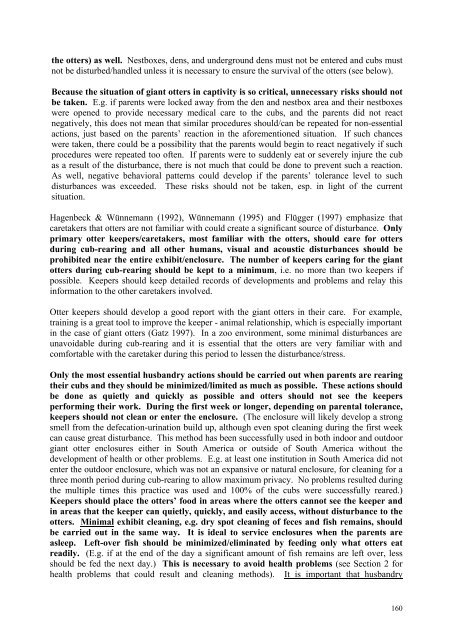International Giant Otter Studbook Husbandry and Management
International Giant Otter Studbook Husbandry and Management
International Giant Otter Studbook Husbandry and Management
You also want an ePaper? Increase the reach of your titles
YUMPU automatically turns print PDFs into web optimized ePapers that Google loves.
the otters) as well. Nestboxes, dens, <strong>and</strong> underground dens must not be entered <strong>and</strong> cubs must<br />
not be disturbed/h<strong>and</strong>led unless it is necessary to ensure the survival of the otters (see below).<br />
Because the situation of giant otters in captivity is so critical, unnecessary risks should not<br />
be taken. E.g. if parents were locked away from the den <strong>and</strong> nestbox area <strong>and</strong> their nestboxes<br />
were opened to provide necessary medical care to the cubs, <strong>and</strong> the parents did not react<br />
negatively, this does not mean that similar procedures should/can be repeated for non-essential<br />
actions, just based on the parents’ reaction in the aforementioned situation. If such chances<br />
were taken, there could be a possibility that the parents would begin to react negatively if such<br />
procedures were repeated too often. If parents were to suddenly eat or severely injure the cub<br />
as a result of the disturbance, there is not much that could be done to prevent such a reaction.<br />
As well, negative behavioral patterns could develop if the parents’ tolerance level to such<br />
disturbances was exceeded. These risks should not be taken, esp. in light of the current<br />
situation.<br />
Hagenbeck & Wünnemann (1992), Wünnemann (1995) <strong>and</strong> Flügger (1997) emphasize that<br />
caretakers that otters are not familiar with could create a significant source of disturbance. Only<br />
primary otter keepers/caretakers, most familiar with the otters, should care for otters<br />
during cub-rearing <strong>and</strong> all other humans, visual <strong>and</strong> acoustic disturbances should be<br />
prohibited near the entire exhibit/enclosure. The number of keepers caring for the giant<br />
otters during cub-rearing should be kept to a minimum, i.e. no more than two keepers if<br />
possible. Keepers should keep detailed records of developments <strong>and</strong> problems <strong>and</strong> relay this<br />
information to the other caretakers involved.<br />
<strong>Otter</strong> keepers should develop a good report with the giant otters in their care. For example,<br />
training is a great tool to improve the keeper - animal relationship, which is especially important<br />
in the case of giant otters (Gatz 1997). In a zoo environment, some minimal disturbances are<br />
unavoidable during cub-rearing <strong>and</strong> it is essential that the otters are very familiar with <strong>and</strong><br />
comfortable with the caretaker during this period to lessen the disturbance/stress.<br />
Only the most essential husb<strong>and</strong>ry actions should be carried out when parents are rearing<br />
their cubs <strong>and</strong> they should be minimized/limited as much as possible. These actions should<br />
be done as quietly <strong>and</strong> quickly as possible <strong>and</strong> otters should not see the keepers<br />
performing their work. During the first week or longer, depending on parental tolerance,<br />
keepers should not clean or enter the enclosure. (The enclosure will likely develop a strong<br />
smell from the defecation-urination build up, although even spot cleaning during the first week<br />
can cause great disturbance. This method has been successfully used in both indoor <strong>and</strong> outdoor<br />
giant otter enclosures either in South America or outside of South America without the<br />
development of health or other problems. E.g. at least one institution in South America did not<br />
enter the outdoor enclosure, which was not an expansive or natural enclosure, for cleaning for a<br />
three month period during cub-rearing to allow maximum privacy. No problems resulted during<br />
the multiple times this practice was used <strong>and</strong> 100% of the cubs were successfully reared.)<br />
Keepers should place the otters’ food in areas where the otters cannot see the keeper <strong>and</strong><br />
in areas that the keeper can quietly, quickly, <strong>and</strong> easily access, without disturbance to the<br />
otters. Minimal exhibit cleaning, e.g. dry spot cleaning of feces <strong>and</strong> fish remains, should<br />
be carried out in the same way. It is ideal to service enclosures when the parents are<br />
asleep. Left-over fish should be minimized/eliminated by feeding only what otters eat<br />
readily. (E.g. if at the end of the day a significant amount of fish remains are left over, less<br />
should be fed the next day.) This is necessary to avoid health problems (see Section 2 for<br />
health problems that could result <strong>and</strong> cleaning methods). It is important that husb<strong>and</strong>ry<br />
160

















